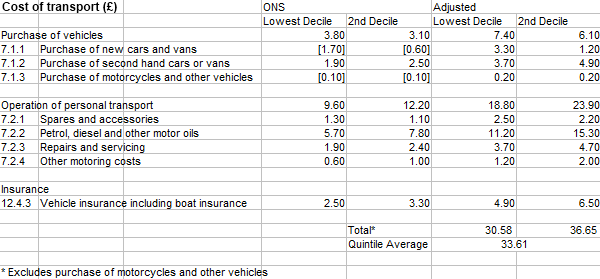Are 80 per cent of households in 'transport poverty'?
"Four in five households are living in "transport poverty", according to figures highlighted by the RAC Foundation."
Daily Star, 29 February 2012
"Pressure for cuts in fuel duty in next month's Budget grew yesterday as experts claimed that 80 per cent of British households are now living in "transport poverty"."
Daily Express, 29 February 2012
Join 72,953 people who trust us to check the facts
Sign up to get weekly updates on politics, immigration, health and more.
Subscribe to weekly email newsletters from Full Fact for updates on politics, immigration, health and more. Our fact checks are free to read but not to produce, so you will also get occasional emails about fundraising and other ways you can help. You can unsubscribe at any time. For more information about how we use your data see our Privacy Policy.
As George Osborne prepares to deliver his third budget later this month, a campaign to persuade the Chancellor to drop proposed fuel duty rises has been heating up.
The Daily Star and the Daily Express reported yesterday morning that 4 out of 5 households are currently living in "transport poverty", defined as where a household spends more than 10 per cent of its disposable income on transport.
The reports refer to figures highlighted by the RAC Foundation, which also claims that those in the poorest fifth spend at least 17 per cent of their income on maintaining a vehicle.
Analysis
The RAC Foundation cites figures published by the Office for National Statistics on the expenditure of households. While the ONS figures divide households into income deciles, the RAC Foundation divide households into five groups by finding the mean of the two deciles in each group.
According to these figures the RAC Foundation's claim initially appears to be broadly correct — four of the five quintiles do spend more than 10 per cent of their disposable income on transport.

(% of household expenditure on transport costs)
However, this represents the proportion of total expenditure going on transport costs, rather than the share of disposable income each household has. There may be other uses - such as savings contributions - which are not included on the list, so it is wrong to use disposable income and expenditure interchangeably.
It should also be noted that the quintiles are averages, and each quintile may well contain households spending less than 10 per cent of its income on transport. We cannopt therefore conclude from this data that 80 per cent ofhouseholds are in 'fuel poverty'.
Vehicle maintenance
The Foundation has also claimed that those in the poorest quintile who own a car spent at least 17 per cent of their income on maintaining a vehicle. Their calculation is a little more complicated for this, and is based on several assumptions.
According to the National Transport Survey (NTS), 49 per cent of the lowest earning quintile do not own a car or van. Subsequently, the RAC Foundation argue that the ONS figures do not give an accurate impression of the transport poverty of car and van owners, since the average cost will be the total spent on car and van ownership and maintenance, divided by the total number of people in the poorest quintile (regardless of whether or not they own a car or van).
In order to compensate for this, they multiply the numbers given by 1.96, add in motor insurance, and then combine the deciles into quintiles as before.

This gives an average cost of £33.61 per week, which is equivalent to 16.8 per cent of total expenditure. Again, this is only as a percentage of expenditure rather than disposable income.
Additionally, maintenance and insurance costs may include costs for motorcycles and other vehicles which are not accounted for by the NTS. Consequently multiplying these figures by 1.96 may exaggerate the cost to car and van owners. Insurance costs also includes boat insurance, although the extent to which this affects the data for the poorest quintile may be negligible.
It is extremely difficult to calculate an accurate figure for the total cost to car and van owners, as the figures cannot be accurately extracted from the ONS data.
Conclusion
While the calculations made by the RAC Foundation can be reproduced, there are several significant caveats to them. In particular, they represent the cost of transport as a percentage of total expenditure, and not as a percentage of disposable income. They are also based on averages for each quintile, suggesting that if a majority of households within a quintile spend more than 10 per cent of their expenditure on transport, all households within that quintile are defined as being in 'transport poverty', when in fact this isn't likely to be the case.
The figure for the cost of car and van ownership for those in the poorest quintile is potentially flawed, as it is based on figures which include ownership of other vehicles such as motorcycles. However it is difficult to find more accurate figures for this, as maintenance of vehicles is not broken down by type of vehicle.